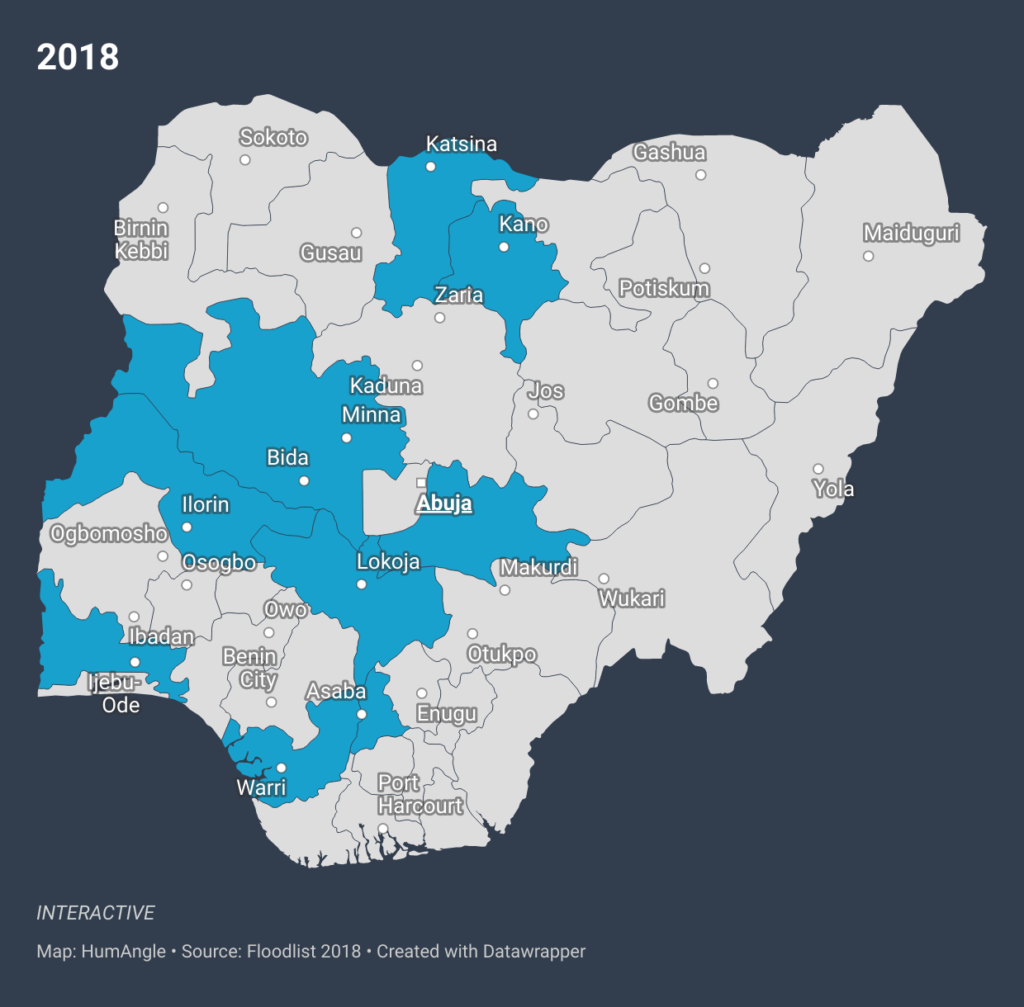REPORT CARD: Nigerian Govt’s Response To Recurrent Floods Under Buhari-led Administration
Nigeria has been grappling with the devastating impact of recurrent floods. HumAngle, through analysis of media reports, examines the federal government's response to flood disasters over the past eight years, highlighting the progress made, areas of weakness, and the need for more proactive measures from the incoming administration to mitigate future disasters.

2015
At the start of the administration floods affected six states, resulting in the loss of 53 lives and displacing over 100,000 people. The incoming government’s response was minimal, with little communication on the issue. However, the National Emergency Management Agency (NEMA) and State Emergency Management Agencies (SEMAs) provided some relief efforts.

2016
NEMA reported better management of floods, citing collaborative efforts with other emergency agencies. Despite flood conditions and water levels comparable to those experienced in 2012, there were fewer casualties and destruction. NEMA’s Disaster Risk Reduction Department played a key role in mitigating the impact.

2017
This year marked a significant engagement of the federal government in response to mass floods. Central Nigeria was heavily affected, with over 100,000 people displaced and a lot of property destroyed. President Muhammadu Buhari expressed condolences and instructed the Vice President to explore long-term solutions. The fund of N1.6 billion was released for 16 flood-ravaged states, but some reported being left out of the allocation.

2018
Severe flooding affected many states, causing extensive damage and displacing approximately 1.9 million people. The federal government declared a state of emergency in nine states and allocated N3 billion for preparedness, response, and mitigation. The establishment of the National Emergency Operational Center and Zonal Emergency Operational Centers enhanced emergency response.

2019
The creation of Emergency Operation Centers (EOCs) before the rainy season in 2o19 marked a significant improvement in flood preparedness. Red alerts were issued in nine states based on flood assessments, marking the government’s turn to a proactive approach to address the upcoming flood season.

2020
The Flood Emergency Preparedness and Response Plan was inaugurated to enhance interagency coordination during flood incidents. The Nigerian Hydrological Services Agency also developed a web-based app for flood disaster mitigation and response planning.

2021
Despite these proactive measures, severe mass floods were experienced in at least six states, resulting in displacement, casualties, and destruction. State governments were criticized for their inadequate response, despite prior warnings from the FG. Nevertheless, NEMA’s newly appointed Director-General commissioned emergency operations centres in 12 states to ensure preparedness.

2022
Record-breaking floods killed over 600 people and injured more than 2,400 persons, displacing 1.4 million people and causing substantial damage to livelihoods and infrastructures. The federal government deployed relief efforts through NEMA, urged state authorities to take responsibility, and sought international humanitarian assistance. Accountability and cooperation between federal and state authorities were highlighted as crucial areas needing improvement.

Moving forward
While the Nigerian government has made strides in addressing flood disasters, weaknesses persist. In the first half of the administration, there was a more reactive approach than proactive. However, in 2018 the president signed a N3 billion preparedness, response, and mitigation plan, effectively ushering in a proactive approach to disaster management in his second term.
Following that trend, the administration inaugurated flood and emergency monitoring technologies which help with preparedness. Despite this, however, the country experienced record-breaking floods in 2022. To this, both the Federal government and its agencies (NEMA and NISHA ) as well as experts have consistently emphasized the need for better oversight, accountability of local authorities, and proactive planning to effectively respond to large-scale disasters, calling on them to step in as first responders without always waiting for federal help.
According to an August 2022 press statement, President Buhari through his media aide Garba Shehu said, “While not a national-level emergency, the ongoing flooding is an emergency nevertheless. Nigerian lives and property are at stake. We call on governors of those states that have swung into action and engaged the necessary gear to continue with their efforts, and those that have not, to immediately face their duties of managing the flooding within their jurisdictions – that is, the job that the President, Governors and council Chairmen have been elected to do.”
The new federal government should continue this proactive approach, but most importantly, hold each state accountable, unlike what this government has failed to do, and work towards comprehensive action plans for flood resilience and response. As the nation braces for future floods, it is imperative that the new regime remain prepared to protect citizens and minimize the impact of these devastating disasters.
Support Our Journalism
There are millions of ordinary people affected by conflict in Africa whose stories are missing in the mainstream media. HumAngle is determined to tell those challenging and under-reported stories, hoping that the people impacted by these conflicts will find the safety and security they deserve.
To ensure that we continue to provide public service coverage, we have a small favour to ask you. We want you to be part of our journalistic endeavour by contributing a token to us.
Your donation will further promote a robust, free, and independent media.
Donate HereStay Closer To The Stories That Matter




